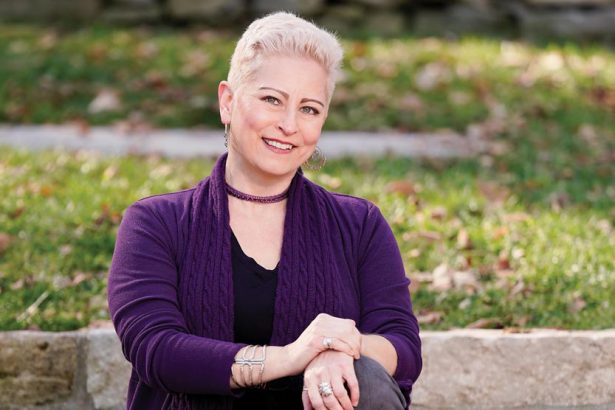Patient Search
 |
 |
|
KaCrole Higgins was diagnosed with breast cancer in 2020. “In May 2020, I found a lump in my breast. I cried. By June, it was diagnosed as breast cancer, triple positive, stage 1A. While getting this cancer diagnosis was devastating, it also became an opportunity. Suddenly, the cancer gave me clarity. It gave me clarity about what was important, what was good in my life, what was toxic in my life, and what I needed to do.” Click below to read more of KaCrole’s story |
If Landon Ryan had been diagnosed with bilateral retinoblastoma 10, 20 or 30 years ago, she might not be here today with nearly perfect vision.Thanks to recent improvements in the treatment for this rare form of cancer that almost exclusively affects children under the age of 5, the diagnosis had the power to change Landon’s life when she was 11 months old, but not to take it — or her eyesight. Click below to learn more about Landon and her story. https://momentum.vicc.org/2022/04/brighter-outlook/ |
A Randomized, Phase 2/3 Study to Investigate the Efficacy and Safety of RP2 in Combination With Nivolumab in Immune Checkpoint Inhibitor-Nave Adult Patients With Metastatic Uveal Melanoma
The purpose of this study is to measure the clinical benefits of the combination of RP2 and nivolumab as compared with the combination of nivolumab and ipilimumab in patients with metastatic uveal melanoma who have not been treated with immune checkpoint inhibitor therapy.
Not Available
II/III
Johnson, Douglas
NCT06581406
VICC-DTMEL24090
Combining Radiation Therapy With Immunotherapy for the Treatment of Metastatic Squamous Cell Carcinoma of the Head and Neck
This phase III trial compares pembrolizumab with radiation therapy to pembrolizumab without radiation therapy (standard therapy) given after pembrolizumab plus chemotherapy for the treatment of patients with squamous cell carcinoma of the head and neck that has spread from where it first started (primary site) to other places in the body (metastatic). Pembrolizumab is a type of immunotherapy that stimulates the body's immune system to fight cancer cells. Pembrolizumab targets and blocks a protein called PD-1 on the surface of certain immune cells called T-cells. Blocking PD-1 triggers the T-cells to find and kill cancer cells. Radiation therapy uses high-powered rays to kill cancer cells. Giving radiation with pembrolizumab may be more effective at treating patients with metastatic head and neck cancer than the standard therapy of giving pembrolizumab alone.
Not Available
III
Choe, Jennifer
NCT05721755
ECOGHNEA3211
Biomarker Platform (Virtual Nodule Clinic) for the Management of Indeterminate Pulmonary Nodules
Lung
Lung
This clinical trial studies whether a biomarker platform, the Virtual Nodule Clinic, can be used for the management of lung (pulmonary) nodules that are not clearly non-cancerous (benign) or clearly cancerous (malignant) (indeterminate pulmonary nodules \[IPNs\]). The management of IPNs is based on estimating the likelihood that the observed nodule is malignant. Many things, such as age, smoking history, and current symptoms, are considered when making a prediction of the likelihood of malignancy. Radiographic imaging characteristics are also considered. Lung nodule management for IPNs can result in unnecessary invasive procedures for nodules that are ultimately determined to be benign, or potential delays in treatment when results of tests cannot be determined or are falsely negative. The Virtual Nodule Clinic is an artificial intelligence (AI) based imaging software within the electronic health record which makes certain that identified pulmonary nodules are screened by clinicians with expertise in nodule management. The Virtual Nodule Clinic also features an AI based radiomic prediction score which designates the likelihood that a pulmonary nodule is malignant. This may improve the ability to manage IPNs and lower unnecessary invasive procedures or treatment delays. Using the Virtual Nodule Clinic may work better for the management of IPNs.
Lung
N/A
Maldonado, Fabien
NCT06638398
VICC-IDTHO24059
(Z)-Endoxifen for the Treatment of Premenopausal Women With ER+/HER2- Breast Cancer
Breast
Breast
This open-label research study is studying (Z)-endoxifen as a possible treatment for pre-menopausal women with ER+/HER2- breast cancer. (Z)-endoxifen belongs to a group of drugs called selective estrogen receptor modulators or "SERM", which help block estrogen from attaching to cancer cells. This study has two parts: a pharmacokinetic part and a treatment part.
The PK part (how the body processes the drug) will enroll about 18 participants. All participants will take (Z)-endoxifen capsules daily. Twelve participants will be randomly assigned (50/50 chance) to take (Z)-endoxifen alone or (Z)-endoxifen with a monthly injection of goserelin a drug that temporarily stops the ovaries from making estrogen. This part will help determine the best dose of (Z)-endoxifen by measuring the drug levels in the blood and how long the body takes to remove it.
The Treatment Cohort has been simplified to a single study arm (Z)-endoxifen + goserelin. Up to 20 participants will be enrolled that have a baseline Ki-67 10% and 45 participants will be enrolled that have a baseline Ki-67\>10%.
A key goal of the study is to see if (Z)-endoxifen can slow down or stop tumor growth as measured by a reduction in Ki-67 levels. Tumor tissue samples will be taken by breast biopsy after about 4 weeks of treatment to check levels of this biomarker. If the tumor shows signs of response, participants can continue treatment for up to 24 weeks or until they have surgery.
Study participation is up to 6 months (24 weeks of treatment) followed by surgery and a one-month follow up visit.
The PK part (how the body processes the drug) will enroll about 18 participants. All participants will take (Z)-endoxifen capsules daily. Twelve participants will be randomly assigned (50/50 chance) to take (Z)-endoxifen alone or (Z)-endoxifen with a monthly injection of goserelin a drug that temporarily stops the ovaries from making estrogen. This part will help determine the best dose of (Z)-endoxifen by measuring the drug levels in the blood and how long the body takes to remove it.
The Treatment Cohort has been simplified to a single study arm (Z)-endoxifen + goserelin. Up to 20 participants will be enrolled that have a baseline Ki-67 10% and 45 participants will be enrolled that have a baseline Ki-67\>10%.
A key goal of the study is to see if (Z)-endoxifen can slow down or stop tumor growth as measured by a reduction in Ki-67 levels. Tumor tissue samples will be taken by breast biopsy after about 4 weeks of treatment to check levels of this biomarker. If the tumor shows signs of response, participants can continue treatment for up to 24 weeks or until they have surgery.
Study participation is up to 6 months (24 weeks of treatment) followed by surgery and a one-month follow up visit.
Breast
II
Abramson, Vandana
NCT05607004
VICCBRE22108
A Study of Oral Nuvisertib (TP-3654) in Patients With Myelofibrosis
Leukemia
Leukemia
This study is a Phase 1/2, multicenter, dose-escalation, open-label trial to assess safety, tolerability, pharmacokinetics and pharmacodynamics of nuvisertib (TP-3654) in patients with intermediate or high-risk primary or secondary MF.
Leukemia
I/II
Kishtagari, Ashwin
NCT04176198
VICC-DTHEM23002P
ResQ201A: Clinical Trial Of N-803 Plus TISLELIZUMAB And DOCETAXEL Versus DOCETAXEL Monotherapy In Participants With Advanced Or Metastatic Non-Small Cell Lung Cancer
Lung
Lung
This is a randomized, open-label, phase 3 clinical trial to compare the efficacy and safety of N-803 plus tislelizumab and docetaxel (experimental arm) versus docetaxel monotherapy (control arm). Enrolled participants will be randomized 2:1 to treatment in the experimental arm or the control arm. Participant randomization will be stratified by geographical region (North America vs Europe vs ASIA vs Other), NSCLC histology (squamous vs nonsquamous), and actionable genomic alteration (AGA); (epidermal growth factor receptor \[EGFR\]/anaplastic lymphoma kinase \[ALK\] vs OTHER AGA vs No AGA).
Lung
III
Wang, Shuai
NCT06745908
VICCTHO24569
A Study Evaluating Single-agent Inavolisib and Inavolisib Plus Atezolizumab in PIK3CA-Mutated Cancers
Multiple Cancer Types
The purpose of the study is to assess the safety and efficacy of inavolisib as a single-agent and in combination with atezolizumab in participants with phosphatidylinositol 4,5-bisphosphate 3-kinase catalytic subunit alpha isoform (PIK3CA)-mutated cancers, including previously treated head and neck squamous cell carcinoma (HNSCC).
Head/Neck,
Phase I
I
Choe, Jennifer
NCT06496568
VICCHNP22118
Testing the Role of DNA Released From Tumor Cells Into the Blood in Guiding the Use of Immunotherapy After Surgical Removal of the Bladder, Kidney, Ureter, and Urethra for Urothelial Cancer Treatment, MODERN Study
This phase II/III trial examines whether patients who have undergone surgical removal of bladder, kidney, ureter or urethra, but require an additional treatment called immunotherapy to help prevent their urinary tract (urothelial) cancer from coming back, can be identified by a blood test. Many types of tumors tend to lose cells or release different types of cellular products including their DNA which is referred to as circulating tumor DNA (ctDNA) into the bloodstream before changes can be seen on scans. Health care providers can measure the level of ctDNA in blood or other bodily fluids to determine which patients are at higher risk for disease progression or relapse. In this study, a blood test is used to measure ctDNA and see if there is still cancer somewhere in the body after surgery and if giving a treatment will help eliminate the cancer. Immunotherapy with monoclonal antibodies, such as nivolumab and relatlimab, can help the body's immune system to attack the cancer, and can interfere with the ability of tumor cells to grow and spread. This trial may help doctors determine if ctDNA measurement in blood can better identify patients that need additional treatment, if treatment with nivolumab prolongs patients' life and whether the additional immunotherapy treatment with relatlimab extends time without disease progression or prolongs life of urothelial cancer patients who have undergone surgical removal of their bladder, kidney, ureter or urethra.
Not Available
II/III
Tan, Alan
NCT05987241
ALLUROA032103
TReatment of ADC-Refractory Breast CancEr With Dato-DXd or T-DXd: TRADE DXd
Breast
Breast
The purpose of this study is to test the safety and effectiveness of the sequence of two investigational drugs (trastuzumab deruxtecan followed by datopotamab deruxtecan, or datopotamab deruxtecan followed by trastuzumab deruxtecan) to learn whether the treatment works in treating HER2-negative (HER2-low or HER2-0) metastatic breast cancer.
The names of the study drugs involved in this study are:
* Datopotamab deruxtecan (a type of antibody drug conjugate)
* Trastuzumab deruxtecan (a type of antibody drug conjugate)
The names of the study drugs involved in this study are:
* Datopotamab deruxtecan (a type of antibody drug conjugate)
* Trastuzumab deruxtecan (a type of antibody drug conjugate)
Breast
II
Abramson, Vandana
NCT06533826
VICC-ITBRE23546
A Study of Lower Radiotherapy Dose to Treat Children With CNS Germinoma
This phase II trial studies how well lower dose radiotherapy after chemotherapy (Carboplatin \& Etoposide) works in treating children with central nervous system (CNS) germinomas. Radiation therapy uses high energy x-rays, particles, or radioactive seeds to kill cancer cells and shrink tumors. Carboplatin is in a class of medications known as platinum-containing compounds. It works in a way similar to the anticancer drug cisplatin, but may be better tolerated than cisplatin. Carboplatin works by killing, stopping or slowing the growth of tumor cells. Etoposide is in a class of medications known as podophyllotoxin derivatives. It blocks a certain enzyme needed for cell division and DNA repair and may kill cancer cells. Researchers want to see if lowering the dose of standard radiotherapy (RT) after chemotherapy can help get rid of CNS germinomas with fewer long-term side effects.
Not Available
II
Esbenshade, Adam
NCT06368817
COGACNS2321


